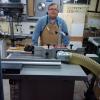Finally got my 3 hp Saw Stop assembled and outlet ran yesterday. Went with the ICS base and just applied the promotion towards the purchase of it. The ICS base is great. Moving the saw around is a breeze. As advertised, the packaging and directions were great. I did spend a fairly large amount of time trying to get the extension wings right. Id say they are not perfect, but I think they are close enough. This is my first time ever using a table saw, so obviously I know next to nothing. One thing I noticed was I feel like I would be a little more comfortable if I could see the cut. With the blade guard on it is kind of tough to see the blade. Seems obvious that is safer to use with the blade guard installed, and maybe it will just take some getting used to. I am still trying to figure out shop layout and I was wondering what most people feel is adequate space to the left of the blade. I know it depends on what you are using the saw for, but just looking for some opinions.




 Reply With Quote
Reply With Quote

 . The fence, miter slots and blade to table alignment are all there to guide your material past the blade in a straight line. Do not try to circumvent this. Granted there are all sorts of tricks, tips and 'tablesaw magic' that we do as we become more familiar with all the things a tablesaw can do. None of these involve a need to see the cut. We may inspect the result of a cut, adjust and repeat an operation; that is pretty normal as one gets used to tablesaw work.
. The fence, miter slots and blade to table alignment are all there to guide your material past the blade in a straight line. Do not try to circumvent this. Granted there are all sorts of tricks, tips and 'tablesaw magic' that we do as we become more familiar with all the things a tablesaw can do. None of these involve a need to see the cut. We may inspect the result of a cut, adjust and repeat an operation; that is pretty normal as one gets used to tablesaw work.




